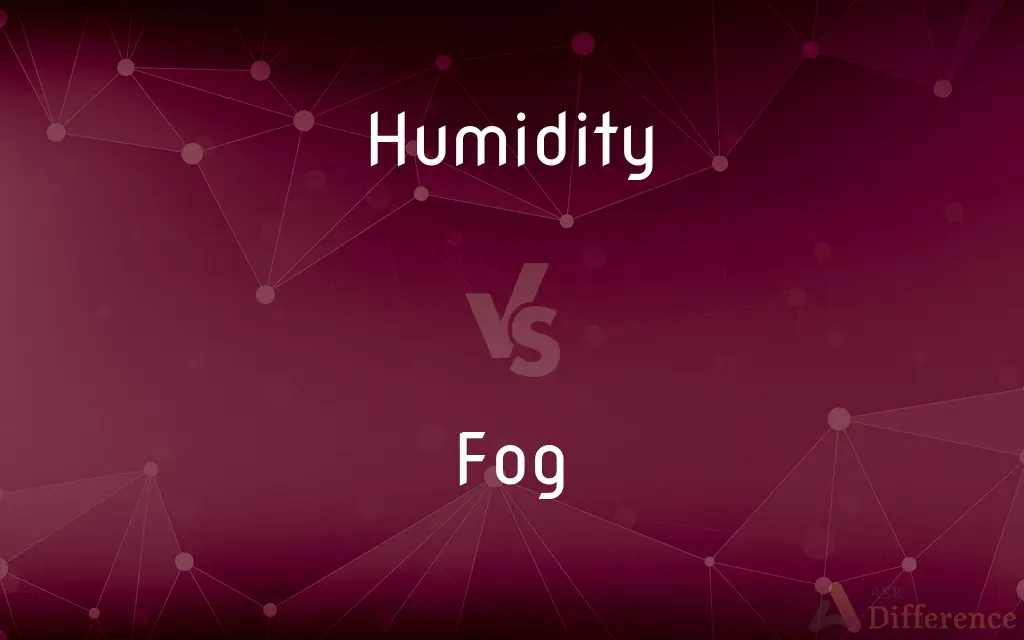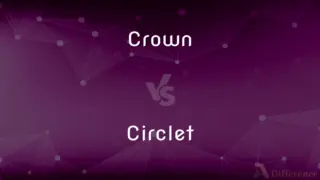Humidity vs. Fog — What's the Difference?
By Tayyaba Rehman & Maham Liaqat — Updated on April 16, 2024
Humidity is the measure of water vapor in the air, while fog is a visible cloud of water droplets near the ground caused by high humidity.

Difference Between Humidity and Fog
Table of Contents
ADVERTISEMENT
Key Differences
Humidity represents the amount of water vapor present in the air, which is essential for determining how humid conditions feel and for weather predictions. On the other hand, fog is a specific weather phenomenon that occurs when humidity reaches 100% and the air becomes saturated, causing water vapor to condense into tiny droplets that are visible as fog.
Humidity can exist at any level without necessarily leading to fog, depending on factors like temperature and air pressure. Whereas, fog requires specific conditions such as cooling air near the dew point and adequate moisture content.
High humidity is often felt as "muggy" or "sticky" air, which can be uncomfortable, especially in warm temperatures. In contrast, fog impacts visibility, which can affect driving conditions, flight schedules, and outdoor activities.
Humidity is typically measured using hygrometers, which can provide readings of relative humidity. On the other hand, the thickness and dispersion of fog are observed visually and can vary significantly from one area to another based on local conditions.
Comparison Chart
Definition
Measure of water vapor in the air
A visible cloud of water droplets near the ground
ADVERTISEMENT
Main Cause
Water vapor content
Condensation of water vapor when air is saturated
Visibility Effects
None
Reduces visibility significantly
Measurement Tools
Hygrometer
Visual observation, weather instruments
Common Occurrences
Any weather condition
Typically during cooler temperatures or changes in air pressure
Compare with Definitions
Humidity
A measure of the water vapor content in the atmosphere.
The humidity today makes the air feel quite oppressive.
Fog
Commonly occurs in valleys, coastal areas, and near bodies of water.
Fog is a frequent morning occurrence by the river.
Humidity
Affects human comfort and weather conditions.
High humidity can exacerbate feelings of heat.
Fog
A type of low-lying cloud close to the ground, reducing visibility.
The heavy fog this morning made driving quite hazardous.
Humidity
Important for various ecological and agricultural processes.
Humidity levels can influence plant growth and pest behavior.
Fog
Forms when the air temperature drops to the dew point.
Overnight cooling often leads to morning fog.
Humidity
Can be indoor or outdoor, impacting health and comfort.
Indoor humidity should be managed to prevent mold growth.
Fog
Often dissipates with sunlight or wind.
The mid-morning sun usually burns off the fog.
Humidity
Expressed as a percentage known as relative humidity.
The relative humidity this morning is 90%.
Fog
Can disrupt transportation and outdoor activities.
The airport was closed temporarily due to dense fog.
Humidity
Humidity is the concentration of water vapour present in the air. Water vapor, the gaseous state of water, is generally invisible to the human eye.
Fog
Fog is a visible aerosol consisting of tiny water droplets or ice crystals suspended in the air at or near the Earth's surface. Fog can be considered a type of low-lying cloud usually resembling stratus, and is heavily influenced by nearby bodies of water, topography, and wind conditions.
Humidity
Dampness, especially of the air.
Fog
A thick cloud of tiny water droplets suspended in the atmosphere at or near the earth's surface which obscures or restricts visibility (to a greater extent than mist; strictly, reducing visibility to below 1 km)
The collision occurred in thick fog
Humidity
Relative humidity.
Fog
A state or cause of perplexity or confusion
The coffee helped clear the fog in my brain
Humidity
Dampness, especially that of the air.
Fog
The grass which grows in a field after a crop of hay has been taken.
Humidity
The amount of water vapour in the air.
Fog
(with reference to a glass surface) cover or become covered with steam
The windscreen was starting to fog up
Hot steam drifted about her, fogging up the window
Humidity
Moisture; dampness; a moderate degree of wetness, which is perceptible to the eye or touch; - used especially of the atmosphere, or of anything which has absorbed moisture from the atmosphere, as clothing.
Fog
Bewilder or puzzle
She stared at him, confusion fogging her brain
Humidity
The content of water vapor in the air, expressed as a percent of the maximum amount of water vapor that the air can hold at the given temperature; also called relative humidity. The capacity of the air to hold moisture increases with temperature, so if the temperature changes without changing the absolute content of the atmospheric moisture, the relative humidity will also change.
Fog
Spray with an insecticide.
Humidity
Wetness in the atmosphere
Fog
Condensed water vapor in cloudlike masses lying close to the ground and limiting visibility.
Fog
An obscuring haze, as of atmospheric dust or smoke.
Fog
A mist or film clouding a surface, as of a window, lens, or mirror.
Fog
A cloud of vaporized liquid, especially a chemical spray used in fighting fires.
Fog
A state of mental vagueness or bewilderment.
Fog
Something that obscures or conceals; a haze
Shrouded their actions in a fog of disinformation.
Fog
A blur on a developed photographic image.
Fog
A new growth of grass appearing on a field that has been mowed or grazed.
Fog
Tall, coarse grass left standing in fields through the winter.
Fog
To cover or envelop with fog.
Fog
To cause to be obscured; cloud.
Fog
To make vague, hazy, or confused
A memory that had been fogged by time.
Fog
To obscure or dim (a photographic image).
Fog
To be covered with fog.
Fog
To be blurred, clouded, or obscured
My glasses fogged in the warm air.
Fog
To be dimmed or obscured. Used of a photographic image.
Fog
(uncountable) A thick cloud that forms near the ground; the obscurity of such a cloud. mist, haze.}}
A bank of fog
Fog
(uncountable) A mist or film clouding a surface.
Fog
A state of mind characterized by lethargy and confusion.
He did so many drugs, he was still in a fog three months after going through detox.
Fog
(photography) A silver deposit or other blur on a negative or developed photographic image.
Fog
(computer graphics) Distance fog.
Fog
A new growth of grass appearing on a field that has been mowed or grazed.
Fog
Tall and decaying grass left standing after the cutting or grazing season.
Fog
(Scotland) Moss.
Fog
(intransitive) To become covered with or as if with fog.
Fog
(intransitive) To become obscured in condensation or water.
The mirror fogged every time he showered.
Fog
To become dim or obscure.
Fog
To make dim or obscure.
Fog
To spoil (film) via exposure to light other than in the normal process of taking a photograph.
Fog
(transitive) To cover with or as if with fog.
Fog
(transitive) To disperse insecticide into (a forest canopy) so as to collect organisms.
Fog
(transitive) To obscure in condensation or water.
Fog
(transitive) To make confusing or obscure.
Fog
To practice in a small or mean way; to pettifog.
Fog
(transitive) To pasture cattle on the fog (of), or aftergrass, of; to eat off the fog from (a field).
Fog
(intransitive) To become covered with the kind of grass called fog.
Fog
A second growth of grass; aftergrass.
Fog
Watery vapor condensed in the lower part of the atmosphere and disturbing its transparency. It differs from cloud only in being near the ground, and from mist in not approaching so nearly to fine rain. See Cloud.
Fog
A state of mental confusion.
Fog
Cloudiness or partial opacity of those parts of a developed film or a photograph which should be clear.
Fog
To pasture cattle on the fog, or aftergrass, of; to eat off the fog from.
Fog
To practice in a small or mean way; to pettifog.
Where wouldst thou fog to get a fee?
Fog
To envelop, as with fog; to befog; to overcast; to darken; to obscure.
Fog
To render semiopaque or cloudy, as a negative film, by exposure to stray light, too long an exposure to the developer, etc.
Fog
To show indistinctly or become indistinct, as the picture on a negative sometimes does in the process of development.
Fog
Droplets of water vapor suspended in the air near the ground
Fog
An atmosphere in which visibility is reduced because of a cloud of some substance
Fog
Confusion characterized by lack of clarity
Fog
Make less visible or unclear;
The stars are obscured by the clouds
Common Curiosities
What is relative humidity?
Relative humidity is the percentage of moisture in the air compared to what the air can hold at that temperature.
Can high humidity exist without fog?
Yes, high humidity can be present without fog if the air temperature does not reach the dew point.
What is the impact of fog on daily activities?
Fog can severely reduce visibility, impacting driving, flying, and maritime navigation.
Does humidity affect weather predictions?
Yes, humidity levels are crucial in forecasting weather, particularly in predicting rain or snow.
Is fog dangerous for driving?
Yes, fog can significantly reduce visibility, making driving conditions dangerous.
How does fog affect air travel?
Fog can lead to flight delays and cancellations due to reduced visibility for takeoff and landing.
What measures can be taken to improve visibility in fog?
Using fog lights and driving slowly can improve safety in foggy conditions.
How does fog form?
Fog forms when the air temperature cools to the dew point and the moisture in the air condenses into tiny liquid droplets.
What time of day is fog most likely to occur?
Fog is most likely to form during the early morning hours and late evening when temperatures are cooler.
How can one reduce indoor humidity?
Using dehumidifiers and proper ventilation can help reduce indoor humidity.
Share Your Discovery

Previous Comparison
Posh vs. Stylish
Next Comparison
Crown vs. CircletAuthor Spotlight
Written by
Tayyaba RehmanTayyaba Rehman is a distinguished writer, currently serving as a primary contributor to askdifference.com. As a researcher in semantics and etymology, Tayyaba's passion for the complexity of languages and their distinctions has found a perfect home on the platform. Tayyaba delves into the intricacies of language, distinguishing between commonly confused words and phrases, thereby providing clarity for readers worldwide.
Co-written by
Maham Liaqat













































